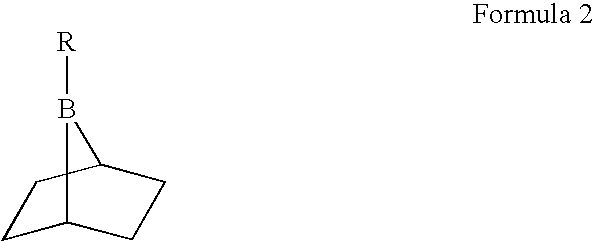Method for preparing high 1,4-cis polybutadiene having controlled cold flow
a polybutadiene and cold flow technology, applied in the field of high 1, 4cis polybutadiene having a controlled cold flow, can solve the problems of poor storability, workability and processability, need for unpacking and reweighing the product, and reduce the productivity, so as to reduce the content of 1,4-cis and the effect of polymerization yield
- Summary
- Abstract
- Description
- Claims
- Application Information
AI Technical Summary
Benefits of technology
Problems solved by technology
Method used
Image
Examples
example 1
[0039]For a polymerization reaction, nitrogen was sufficiently blown into a 360 ml of pressure reactor. To the reactor containing 150 g of solvent (a mixture of cyclohexane and heptane, 9:1, wt / wt) were sequentially added triisobutylaluminum (1M solution in hexane), diisobutylaluminum hydride (1M solution in hexane), diisobutylaluminum chloride (1.5% solution in cyclohexane), and neodymium(versatic acid)(versatate)3 (1.44% solution in cyclohexane) including 0.02 g of 1,3-butadiene with a mol ratio of 35:5:2:1, respectively.
[0040]After the addition of 1,3-butadiene as a monomer, the polymerization reaction was performed at 40° C. for 30 minutes. Then 10 equivalents of triethylborane compound to neodymium(versatic acid)(versatate)3 was added as a cold flow controller, and the polymerization reaction was further performed at the same reaction temperature for 150 minutes. The weight ratio of the polymerization solvent to the monomer was 5, and 1.4×10−4 mol of the neodymium catalyst was ...
examples 2 to 10
[0041]The procedures were performed in the same manner as described in Example 1, excepting for the amount of the triethylborane compound, the addition time of the triethylborane compound, the type of the neodymium catalyst, and the addition order of the catalyst, as presented in Table 1.
[0042]
TABLE 1Addition1,4-cisBEt3(2)order ofCold flowMooneycontentsYieldadditionDiv.catalyst(1)mol ratio(mg / min)viscosity(%)(%)time(min.)Example 1Al(i-Bu)3 / 35:5:2:1:102.0932.597.210030Example 2Al(i-Bu)2H / 35:5:2:1:201.0836.597.010030Example 3Al(i-Bu)2Cl / 35:5:2:1:300.7548.596.910030Example 4Nd(VA)(vers)3 / 35:5:2:1:400.6242.596.810030Example 5BEt335:5:2:1:500.3947.096.710030Example 6Al(i-Bu)3 / 35:5:2:1:12.6140.097.510060Example 7Al(i-Bu)2H / 35:5:2:1:50.6355.297.510060Al(i-Bu)2Cl / Nd(vers)3 / BEt3Example 8Nd(vers)3 / 1:35:5:2:201.0237.597.010030Al(i-Bu)3 / Al(i-Bu)2H / Al(i-Bu)2Cl / BEt3Example 9Al(i-Bu)2H / 5:35:2:1:201.0437.097.210030Al(i-Bu)3 / Al(i-Bu)2Cl / Nd(vers)3 / BEt3Example 10Al(i-Bu)2Cl / 2:35:5:1:201.0837.097.21003...
examples 11 to 17
[0044]The procedures were performed in the same manner as described in Example 1, excepting for the addition time of triethylborane, the type of neodymium catalyst, and the addition order of the catalyst, as presented in Table 2.
[0045]
TABLE 21,4-cisBEt3(2)Addition orderCold flowMooneycontentsYieldadditionDiv.of catalyst(1)mol ratio(mg / min)viscosity(%)(%)time(min.)ExampleAl(i-Bu)3 / 35:5:2:1:200.7433.097.01002011Al(i-Bu)2H / ExampleAl(i-Bu)2Cl / 35:5:2:1:200.9543.097.51006012Nd(VA)(vers)3 / ExampleBEt335:5:2:1:201.2041.097.81009013Example35:5:2:1:201.3044.097.710012014Example35:5:2:1:201.2750.097.610015015ExampleNd(vers)3 / 1:2:5:35:201.0043.097.51006016Al(i-Bu)2Cl / Al(i-Bu)2H / Al(i-Bu)3 / BEt3ExampleAl(i-Bu)2H / 5:35:2:1:200.9743.597.81006017Al(i-Bu)3 / Al(i-Bu)2Cl / Nd(vers)3 / BEt3Note: (1)In the polymerization catalyst, Al(i-Bu)3: triisobutylaluminum, Al(i-Bu)2H: diisobutylaluminum hydride Al(i-Bu)2Cl: diisobutylaluminum chloride, Nd(VA)(vers)3: Nd(versatic acid)(versatate)3, BEt3: triethylborane, Nd(...
PUM
| Property | Measurement | Unit |
|---|---|---|
| time | aaaaa | aaaaa |
| molecular weight distribution | aaaaa | aaaaa |
| temperature | aaaaa | aaaaa |
Abstract
Description
Claims
Application Information
 Login to View More
Login to View More - R&D
- Intellectual Property
- Life Sciences
- Materials
- Tech Scout
- Unparalleled Data Quality
- Higher Quality Content
- 60% Fewer Hallucinations
Browse by: Latest US Patents, China's latest patents, Technical Efficacy Thesaurus, Application Domain, Technology Topic, Popular Technical Reports.
© 2025 PatSnap. All rights reserved.Legal|Privacy policy|Modern Slavery Act Transparency Statement|Sitemap|About US| Contact US: help@patsnap.com



